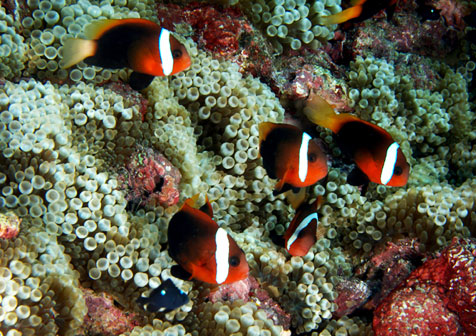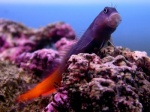fish of the week
2 posters
Page 1 of 1
 fish of the week
fish of the week

Social grouping with mass of Bubble-Tip Anemones. Nick Hobgood/Creative Commons
Overview
This is a durable, but potentially quarrelsome aquarium inhabitant. It is a greedy eater and a nearly bulletproof beginner's fish, but must not be confined in small aquarium with easily intimidated species.
Adults are best kept with more aggressive tankmates. In a larger tank, it is possible to keep A. melanopus with more peaceful fishes. If you want to see it interact with a sea anemone, add a Bubble-Tip Anemone, E. quadricolor (it tends to prefer the colonial form of this species). However, it will readily acclimate to the aquarium even if not kept with a host.
Adults of this species are usually brick red with black on the body, pelvic fins, and anal fins. There is a single head bar that can be blue or white. The juveniles may have one or two additional body bars. Females often have a blanched or whitish “face,” while in males the head is bright red.
This species is very similar to the Tomato Clownfish (A. frenatus) but differs in having black pelvic fins. Males are not bright orange like A. frenatus, but are red or dull reddish brown. Populations of A. melanopus from Fiji, Tonga, and the Society Islands, as well as the Coral Sea, differ in color from those found in other parts of the western Pacific. Those individuals from the three former locations are reddish orange overall with a white head bar and no black saddle, or black on the pelvic and anal fins (they look more like male A. frenatus).
Individuals from the Coral Sea can be orangish overall with a dark brown spot on the body, and often lack the head band.
Family: Pomacentridae
Other common name(s):
- Dusky Clownfish
- Red and Black Anemonefish
- Melanopus Anemonefish
- Cinnamon Clownfish
Native range:
- Pacific Ocean
- Bali
- Society Islands
- Mariana Islands
- Great Barrier Reef
Habitat: This fish is found in lagoons and on reef flats and reef faces at depths of 1 to at least 18 m (3.3. to 59 ft.). The Dusky Anemonefish is usually found in the colonial morph of Bubble-Tip Anemone, Entacmaea quadricolor and less frequently associates with Heteractis crispa and H. magnifica. The clusters of the cloning form of the E. quadricolor often cover large areas of the reef surface. These are occupied by aggregations of juveniles, subadults, and adult A. melanopus. As many as 150 individuals have been reported from a colony of E. quadricolor that covered an area of 36 sq. meters (387 sq. ft.). Male-female A. melanopus pairs defend a territory that may consist of several of the small anemone clones. If the group of anemones is smaller, the adult pair may defend the entire colony. Juveniles tend to occupy smaller anemones at the periphery of the E. quadricolor colony, while the largest fish tend to inhabit the center of the anemone colony. Females are more aggressive than the males. Adults regularly displace smaller consexuals in established pairs or replace consexuals that disappear before a subadult can change sex and fill the vacancy (see A. frenatus for more on this phenomenon). Juvenile Great Barrier Reef (A. akindynos) and young Maroon Clownfish (P. aculeatus) are occasionally found at the periphery of the colonies occupied by A. melanopus. I have also seen this species living in E. quadricolor next to H. crispa that contained A. clarkii. The Dusky Anemonefish would occasionally attack their A. clarkii neighbors, and temporarily drive them out of their host. In Guam, this species will spawn an average of twice per lunar month. Spawning lasts about one and a half hours and usually occurs two or three hours after the sun sets. The average number of eggs per nest is 300. Ross (1977) estimated the annual fecundity of this species to be around 7,200 eggs.
Maximum length: 12 cm (5 in)
Minimum aquarium size: 114 L (30 gal)
Water: Marine 23 °C (296 K, 73 °F) - 27 °C (300 K, 81 °F)
GA_googleAddSlot("ca-pub-5541711581822576", "MAQX-Banner-Inline-Species-468x60");
GA_googleFetchAds();
GA_googleFillSlot("MAQX-Banner-Inline-Species-468x60");
Feeding
It is reported to feed primarily on planktonic copepods and algae. However, it will also eat small crustaceans, worms, tunicate larvae, sea spiders, barnacle appendages, and fish eggs (individuals tending a nest will eat infected eggs).
Offer a mixed diet of plankton-type foods (enriched adult Brine Shrimp, Mysis Shrimp, and reef fish rations containing marine algae. Can be fed minced table shrimp, squid, and other seafoods.
Aquarium Compatibility
Can be belligerent.
These anemonefishes should be kept singly or in mated pairs, and should not be housed with similar species.
It has been known to hybridize in captivity with the Red Saddleback Clownfish (A. ephippium) and Tomato Clownfish (A. frenatus).
Breeding/Propagation
Easy to breed, with easy-to-rear-larvae.
Demersal spawners with parental care of eggs by both male and female. Larvae drift up and into the plankton until they settle out.
Hoff (1996) reports that captive females deposit from 172 to 339 eggs per nest (with an average of 249). The rate of hatching is low in this species, but the survival rate of the larvae is relatively high. Eggs hatch in 8 to 10 days. Metamorphosis occurs on about the eighth day after hatching.
Joyce Wilkerson in her classic Clownfishes book recommends a 40-gallon tank for a pair.

HSCmember- Great White

- Location : Bemidji
Number of posts : 560
 Re: fish of the week
Re: fish of the week
HSCmember wrote:Aquarium Compatibility
Can be belligerent.
Sounds like clownfish alright! I love em but they are nasty suckers, at least the larger species.

GoingPostal- Mod

- Location : Int'l Falls, MN
Number of posts : 1479
Age : 38
Page 1 of 1
Permissions in this forum:
You cannot reply to topics in this forum|
|
|

 Home
Home